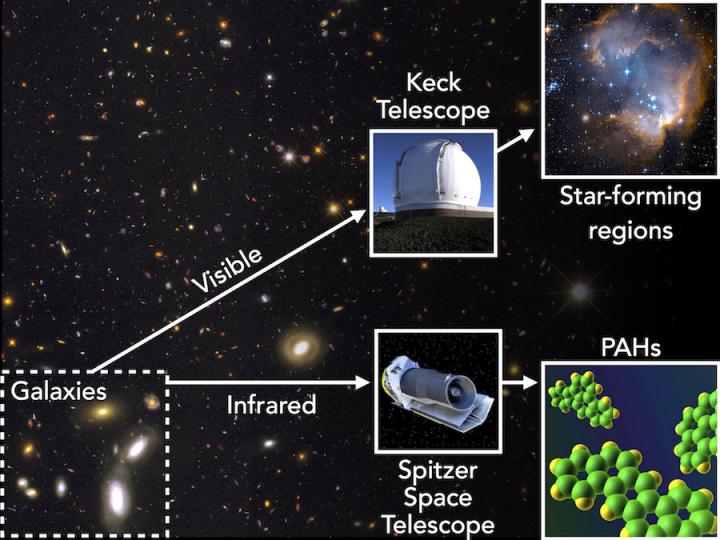Tracing aromatic molecules in the early universe

In this study, astronomers used data from the Keck and Spitzer telescopes to trace the star forming and dusty regions of galaxies at about 10 billion years ago. The picture in the background shows the GOODS field, one of the five regions in the sky that was observed for this study. Credit: Mario De Leo-Winkler with images from the Spitzer Space Telescope, NASA, ESA and the Hubble Heritage team.
A molecule found in car engine exhaust fumes that is thought to have contributed to the origin of life on Earth has made astronomers heavily underestimate the amount of stars that were forming in the early Universe, a University of California, Riverside-led study has found.
That molecule is called polycyclic aromatic hydrocarbon (PAH). On Earth it is also found in coal and tar. In space, it is a component of dust, which along with gas, fills the space between stars within galaxies.
The study, which was just published in the Astrophysical Journal, represents the first time that astronomers have been able to measure variations of PAH emissions in distant galaxies with different properties. It has important implications for the studies of distant galaxies because absorption and emission of energy by dust particles can change astronomers' views of distant galaxies.
“Despite the ubiquity of PAHs in space, observing them in distant galaxies has been a challenging task,” said Irene Shivaei, a graduate student at UC Riverside, and leader of the study. “A significant part of our knowledge of the properties and amounts of PAHs in other galaxies is limited to the nearby universe.”
The research was conducted as part of the University of California-based MOSDEF survey, a study that uses the Keck telescope in Hawaii to observe the content of about 1,500 galaxies when the universe was 1.5 to 4.5 billion years old. The researchers observed the emitted visible-light spectra of a large and representative sample of galaxies during the peak-era of star formation activity in the universe.
In addition, the researchers incorporated infrared imaging data from the NASA Spitzer Space Telescope and the European Space Agency-operated Herschel Space Observatory to trace the polycyclic aromatic hydrocarbon emission in mid-infrared bands and the thermal dust emission in far-infrared wavelengths.
The researchers concluded that the emission of polycyclic aromatic hydrocarbon molecules is suppressed in low-mass galaxies, which also have a lower fraction of metals, which are atoms heavier than hydrogen and helium. These results indicate that the polycyclic aromatic hydrocarbon molecules are likely to be destroyed in the hostile environment of low-mass and metal-poor galaxies with intense radiation.
The researchers also found that the polycyclic aromatic hydrocarbon emission is relatively weaker in young galaxies compared to older ones, which may be due to the fact that polycyclic aromatic hydrocarbon molecules are not produced in large quantities in young galaxies.
They found that the star-formation activity and infrared luminosity in the universe 10 billion years ago is approximately 30 percent higher than previously measured.
Studying the properties of the polycyclic aromatic hydrocarbon mid-infrared emission bands in distant universe is of fundamental importance to improving our understanding of the evolution of dust and chemical enrichment in galaxies throughout cosmic time. The planned launch of the James Webb Space Telescope in 2018 will push the boundaries of our knowledge on dust and polycyclic aromatic hydrocarbon in the early universe.
###
The Astrophysical Journal paper is called “The MOSDEF Survey: Metallicity Dependence of PAH Emission at High Redshift and Implications for 24 μm Inferred IR Luminosities and Star Formation Rates at z ∼ 2.”
In addition to Shivaei, the authors are: Naveen Reddy, Brian Siana, and Bahram Mobasher, of UC Riverside; Alice Shapley and Ryan L. Sanders, of UCLA; Mariska Kriek, Sedona H. Price, and Tom Zick, of UC Berkeley; and Alison L. Coil and Mojegan Azadi, of UC San Diego.
Mario De Leo-Winkler, a postdoctoral researcher in the UCR Department of Physics and Astronomy, made significant contributions to this article.
The University of California, Riverside is a doctoral research university, a living laboratory for groundbreaking exploration of issues critical to Inland Southern California, the state and communities around the world. Reflecting California's diverse culture, UCR's enrollment is now nearly 23,000 students. The campus opened a medical school in 2013 and has reached the heart of the Coachella Valley by way of the UCR Palm Desert Center. The campus has an annual statewide economic impact of more than $1 billion. A broadcast studio with fiber cable to the AT&T Hollywood hub is available for live or taped interviews. UCR also has ISDN for radio interviews. To learn more, call (951) UCR-NEWS.
Media Contact
All latest news from the category: Physics and Astronomy
This area deals with the fundamental laws and building blocks of nature and how they interact, the properties and the behavior of matter, and research into space and time and their structures.
innovations-report provides in-depth reports and articles on subjects such as astrophysics, laser technologies, nuclear, quantum, particle and solid-state physics, nanotechnologies, planetary research and findings (Mars, Venus) and developments related to the Hubble Telescope.
Newest articles

Superradiant atoms could push the boundaries of how precisely time can be measured
Superradiant atoms can help us measure time more precisely than ever. In a new study, researchers from the University of Copenhagen present a new method for measuring the time interval,…

Ion thermoelectric conversion devices for near room temperature
The electrode sheet of the thermoelectric device consists of ionic hydrogel, which is sandwiched between the electrodes to form, and the Prussian blue on the electrode undergoes a redox reaction…

Zap Energy achieves 37-million-degree temperatures in a compact device
New publication reports record electron temperatures for a small-scale, sheared-flow-stabilized Z-pinch fusion device. In the nine decades since humans first produced fusion reactions, only a few fusion technologies have demonstrated…





















